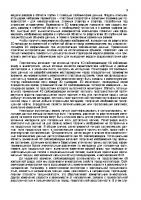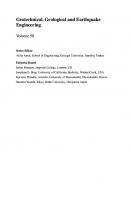Seismic Analysis of Structures and Equipment 9783030578572, 9783030578589
This book describes methods used to estimate forces and deformations in structures during future earthquakes. It synthes
312 66 14MB
English Pages 272 [280] Year 2021
Table of contents :
Preface
Acknowledgments
Contents
Chapter 1: Ground Motions from Past Earthquakes
1.1 Introduction
1.2 Amplitude of Ground Motion
1.3 Single-Degree-of-Freedom System
1.4 Dynamic Response of a SDOF System
1.5 Deformation Response Spectrum
1.6 Pseudo-Acceleration Response Spectrum
1.7 Pseudo-Velocity Response Spectrum
1.8 Tripartite Response Spectrum
1.9 Central Period and Normalized Velocity
1.10 Response Spectrum of Incompatible Acceleration, Velocity, and Displacement Histories
1.11 Smooth Response Spectrum of Ground Motion
1.12 Example: Smooth Response Spectrum from PGA, PGV, and PGD
1.13 Comparison with Newmark-Hall Response Spectrum
1.14 Building Code Response Spectra
1.15 Acceleration-Deformation Response Spectrum
1.16 Strength and Deformation Demands
1.17 Unique Nature of Seismic Loads
1.18 Energy Demand ED
1.19 Summary
References
Chapter 2: Ground Motions for Future Earthquakes
2.1 Introduction
2.2 Prediction of PGA, PGV, and PGD at a Site
2.2.1 Example: PSHA of a Site
2.2.2 Probability of Exceedance
2.2.3 Example: PSHA of a Real Site
2.3 Response Spectra of Vertical Ground Motion
2.4 Building Code Response Spectra and Expected Performance
2.5 Ground Motion Histories for Dynamic Analyses
2.5.1 Example: Ground Motion Histories for 2D Analyses
2.5.2 Example: Ground Motion Histories for 3D Analyses
2.5.3 Unequal Ground Motions in Two Horizontal Directions
2.6 Response Spectra for Various Values of Damping
2.7 Demand Surface
2.8 Energy Demand for SFBA Site
2.9 Structure Types for Different Sites
2.10 Summary
References
Chapter 3: Seismic Response of One-Story Buildings
3.1 Introduction
3.2 One-Story Moment Frame
3.3 Ground Motion
3.4 Linear-Static Analysis
3.5 Linear-Dynamic Analysis
3.6 Need for Nonlinear Analysis
3.7 Nonlinear-Static Analysis
3.7.1 Pushover Curve
3.7.2 Capacity Curve
3.7.3 Damping Curve
3.7.4 Deformation-Versus-Damping Curve
3.7.5 Responses at Equilibrium
3.7.6 Expected Performance
3.7.7 3D Visualization of Nonlinear-Static Analysis
3.8 Nonlinear-Dynamic Analysis
3.9 Design of Connections
3.10 Uncertainty in Strength of Structural Elements
3.11 Pros and Cons of Different Types of Analysis
3.12 Knee-Braced Frame
3.13 Eccentric Braced Frame
3.14 Tension-Only Braced Frame
3.15 Effect of Torsional Eccentricity
3.16 Seismic Design Steps
3.17 Summary
References
Chapter 4: Seismic Response of Multistory Buildings
4.1 Introduction
4.2 Properties of MF
4.3 Ground Motion
4.4 Linear-Static Analysis
4.4.1 Modal Properties
4.4.2 Modal Responses
4.5 Linear-Dynamic Analysis
4.6 Comments on Linear Analyses
4.7 Nonlinear-Static Analysis
4.7.1 Pushover Curve
4.7.2 Capacity Curve
4.7.3 Damping Curve
4.7.4 Deformation-Versus-Damping Curve
4.7.5 Responses at Equilibrium
4.7.6 Expected Performance
4.7.7 3D Visualization of Nonlinear-Static Analysis
4.8 Nonlinear-Dynamic Analysis
4.9 Pros and Cons of Different Methods of Analysis
4.10 Design of Connections
4.11 Uncertainty in the Strength of Structural Elements
4.12 Effect of Height on Building Vulnerability
4.13 Effect of Soft-Story on Building Vulnerability
4.14 Effect of Braces
4.15 Summary
References
Chapter 5: Sliding of Objects During Earthquakes
5.1 Introduction
5.2 Sliding or Rocking
5.3 Equation of Motion
5.4 Ground Motion
5.5 Nonlinear-Dynamic Analysis
5.5.1 Response to Horizontal Shaking
5.5.2 Effects of Vertical Ground Motion
5.5.3 Comments on Dynamic Analysis
5.6 Nonlinear-Static Analysis
5.6.1 Demand Curve
5.6.2 Capacity Curve
5.6.3 Sliding Response
5.7 ASCE 43-05 Method
5.8 Static and Dynamic Friction
5.9 Sliding Response of Flexible Object
5.9.1 Capacity Curve
5.9.2 Damping Curve
5.9.3 Sliding Response
5.9.4 Anchored Versus Unanchored
5.10 Effects of Foundation Tilt
5.11 Summary
References
Chapter 6: Rocking of Objects During Earthquakes
6.1 Introduction
6.2 Equation of Motion
6.3 Free-Vibration Response
6.4 Ground Motion
6.5 Nonlinear-Dynamic Analysis
6.6 Nonlinear-Static Analysis
6.7 Safety Margin against Toppling
6.8 Toppling Response Spectrum
6.9 Summary
References
Chapter 7: Seismic Response of Storage Racks
7.1 Introduction
7.2 Structural System
7.3 Ground Motion
7.4 Cross-Aisle Responses
7.4.1 Nonlinear-Static Analysis in CA Direction
7.4.2 Nonlinear-Dynamic Analysis in CA Direction
7.5 Down-Aisle Responses
7.5.1 Nonlinear-Static Analysis in DA Direction
7.5.2 Nonlinear-Dynamic Analysis in DA Direction
7.6 Summary
References
Chapter 8: Seismic Response of Liquid-Storage Tanks
8.1 Introduction
8.2 Example Tank
8.3 Ground Motion
8.4 Linear Analysis of Fixed-Base Tank
8.4.1 Model of Fixed-Base Tank
8.4.2 Sloshing Wave Height
8.4.3 Revised Model of Fixed-Base Tank
8.4.4 Responses of Fixed-Base Tank
8.4.5 Linear Analysis of Flexibly Supported Tank
8.4.5.1 Model of Flexibly Supported Tank
8.4.6 Responses of Flexibly Supported Tank
8.5 Nonlinear Analysis of Tank
8.5.1 Nonlinear Model
8.5.2 Pushover and Damping Curves
8.5.3 Pushover Analysis
8.5.4 Effect of Increasing Anchorage
8.6 Summary
References
Chapter 9: Seismic Response of Gantry Cranes
9.1 Introduction
9.2 Lumped Masses
9.3 Ground Motion
9.4 Elastic Analyses
9.4.1 Configuration 1
9.4.2 Configuration 2
9.4.3 Conclusions from Elastic Analyses
9.5 Inelastic Analyses
9.5.1 Configuration 1
9.5.2 Performance of Gantry in Configuration 1
9.5.3 Configuration 2
9.5.4 Performance of Gantry in Configuration 2
9.6 Design of Column Connection
9.7 Summary
References
Index
Preface
Acknowledgments
Contents
Chapter 1: Ground Motions from Past Earthquakes
1.1 Introduction
1.2 Amplitude of Ground Motion
1.3 Single-Degree-of-Freedom System
1.4 Dynamic Response of a SDOF System
1.5 Deformation Response Spectrum
1.6 Pseudo-Acceleration Response Spectrum
1.7 Pseudo-Velocity Response Spectrum
1.8 Tripartite Response Spectrum
1.9 Central Period and Normalized Velocity
1.10 Response Spectrum of Incompatible Acceleration, Velocity, and Displacement Histories
1.11 Smooth Response Spectrum of Ground Motion
1.12 Example: Smooth Response Spectrum from PGA, PGV, and PGD
1.13 Comparison with Newmark-Hall Response Spectrum
1.14 Building Code Response Spectra
1.15 Acceleration-Deformation Response Spectrum
1.16 Strength and Deformation Demands
1.17 Unique Nature of Seismic Loads
1.18 Energy Demand ED
1.19 Summary
References
Chapter 2: Ground Motions for Future Earthquakes
2.1 Introduction
2.2 Prediction of PGA, PGV, and PGD at a Site
2.2.1 Example: PSHA of a Site
2.2.2 Probability of Exceedance
2.2.3 Example: PSHA of a Real Site
2.3 Response Spectra of Vertical Ground Motion
2.4 Building Code Response Spectra and Expected Performance
2.5 Ground Motion Histories for Dynamic Analyses
2.5.1 Example: Ground Motion Histories for 2D Analyses
2.5.2 Example: Ground Motion Histories for 3D Analyses
2.5.3 Unequal Ground Motions in Two Horizontal Directions
2.6 Response Spectra for Various Values of Damping
2.7 Demand Surface
2.8 Energy Demand for SFBA Site
2.9 Structure Types for Different Sites
2.10 Summary
References
Chapter 3: Seismic Response of One-Story Buildings
3.1 Introduction
3.2 One-Story Moment Frame
3.3 Ground Motion
3.4 Linear-Static Analysis
3.5 Linear-Dynamic Analysis
3.6 Need for Nonlinear Analysis
3.7 Nonlinear-Static Analysis
3.7.1 Pushover Curve
3.7.2 Capacity Curve
3.7.3 Damping Curve
3.7.4 Deformation-Versus-Damping Curve
3.7.5 Responses at Equilibrium
3.7.6 Expected Performance
3.7.7 3D Visualization of Nonlinear-Static Analysis
3.8 Nonlinear-Dynamic Analysis
3.9 Design of Connections
3.10 Uncertainty in Strength of Structural Elements
3.11 Pros and Cons of Different Types of Analysis
3.12 Knee-Braced Frame
3.13 Eccentric Braced Frame
3.14 Tension-Only Braced Frame
3.15 Effect of Torsional Eccentricity
3.16 Seismic Design Steps
3.17 Summary
References
Chapter 4: Seismic Response of Multistory Buildings
4.1 Introduction
4.2 Properties of MF
4.3 Ground Motion
4.4 Linear-Static Analysis
4.4.1 Modal Properties
4.4.2 Modal Responses
4.5 Linear-Dynamic Analysis
4.6 Comments on Linear Analyses
4.7 Nonlinear-Static Analysis
4.7.1 Pushover Curve
4.7.2 Capacity Curve
4.7.3 Damping Curve
4.7.4 Deformation-Versus-Damping Curve
4.7.5 Responses at Equilibrium
4.7.6 Expected Performance
4.7.7 3D Visualization of Nonlinear-Static Analysis
4.8 Nonlinear-Dynamic Analysis
4.9 Pros and Cons of Different Methods of Analysis
4.10 Design of Connections
4.11 Uncertainty in the Strength of Structural Elements
4.12 Effect of Height on Building Vulnerability
4.13 Effect of Soft-Story on Building Vulnerability
4.14 Effect of Braces
4.15 Summary
References
Chapter 5: Sliding of Objects During Earthquakes
5.1 Introduction
5.2 Sliding or Rocking
5.3 Equation of Motion
5.4 Ground Motion
5.5 Nonlinear-Dynamic Analysis
5.5.1 Response to Horizontal Shaking
5.5.2 Effects of Vertical Ground Motion
5.5.3 Comments on Dynamic Analysis
5.6 Nonlinear-Static Analysis
5.6.1 Demand Curve
5.6.2 Capacity Curve
5.6.3 Sliding Response
5.7 ASCE 43-05 Method
5.8 Static and Dynamic Friction
5.9 Sliding Response of Flexible Object
5.9.1 Capacity Curve
5.9.2 Damping Curve
5.9.3 Sliding Response
5.9.4 Anchored Versus Unanchored
5.10 Effects of Foundation Tilt
5.11 Summary
References
Chapter 6: Rocking of Objects During Earthquakes
6.1 Introduction
6.2 Equation of Motion
6.3 Free-Vibration Response
6.4 Ground Motion
6.5 Nonlinear-Dynamic Analysis
6.6 Nonlinear-Static Analysis
6.7 Safety Margin against Toppling
6.8 Toppling Response Spectrum
6.9 Summary
References
Chapter 7: Seismic Response of Storage Racks
7.1 Introduction
7.2 Structural System
7.3 Ground Motion
7.4 Cross-Aisle Responses
7.4.1 Nonlinear-Static Analysis in CA Direction
7.4.2 Nonlinear-Dynamic Analysis in CA Direction
7.5 Down-Aisle Responses
7.5.1 Nonlinear-Static Analysis in DA Direction
7.5.2 Nonlinear-Dynamic Analysis in DA Direction
7.6 Summary
References
Chapter 8: Seismic Response of Liquid-Storage Tanks
8.1 Introduction
8.2 Example Tank
8.3 Ground Motion
8.4 Linear Analysis of Fixed-Base Tank
8.4.1 Model of Fixed-Base Tank
8.4.2 Sloshing Wave Height
8.4.3 Revised Model of Fixed-Base Tank
8.4.4 Responses of Fixed-Base Tank
8.4.5 Linear Analysis of Flexibly Supported Tank
8.4.5.1 Model of Flexibly Supported Tank
8.4.6 Responses of Flexibly Supported Tank
8.5 Nonlinear Analysis of Tank
8.5.1 Nonlinear Model
8.5.2 Pushover and Damping Curves
8.5.3 Pushover Analysis
8.5.4 Effect of Increasing Anchorage
8.6 Summary
References
Chapter 9: Seismic Response of Gantry Cranes
9.1 Introduction
9.2 Lumped Masses
9.3 Ground Motion
9.4 Elastic Analyses
9.4.1 Configuration 1
9.4.2 Configuration 2
9.4.3 Conclusions from Elastic Analyses
9.5 Inelastic Analyses
9.5.1 Configuration 1
9.5.2 Performance of Gantry in Configuration 1
9.5.3 Configuration 2
9.5.4 Performance of Gantry in Configuration 2
9.6 Design of Column Connection
9.7 Summary
References
Index

![Seismic Analysis of Structures and Equipment [1st ed.]
9783030578572, 9783030578589](https://ebin.pub/img/200x200/seismic-analysis-of-structures-and-equipment-1st-ed-9783030578572-9783030578589.jpg)
![Seismic Analysis of Structures and Equipment [1st ed. 2021]
9783030578589, 9783030578572, 3030578585](https://ebin.pub/img/200x200/seismic-analysis-of-structures-and-equipment-1st-ed-2021-9783030578589-9783030578572-3030578585.jpg)
![Seismic Design Aids for Nonlinear Analysis of Reinforced Concrete Structures [1 ed.]
1439809143, 9781439809143](https://ebin.pub/img/200x200/seismic-design-aids-for-nonlinear-analysis-of-reinforced-concrete-structures-1nbsped-1439809143-9781439809143.jpg)






